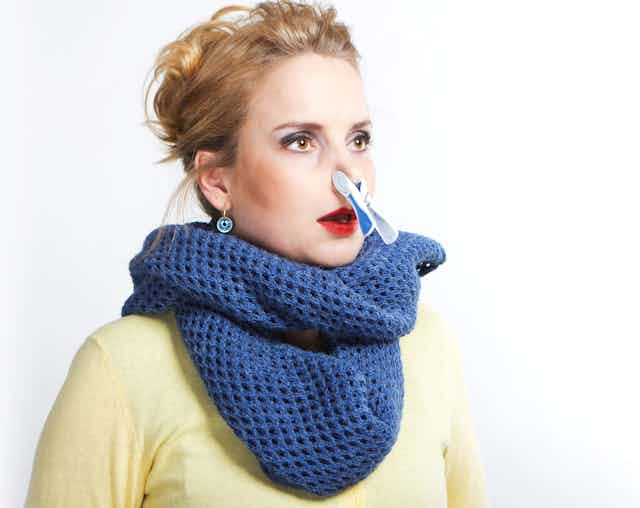This is an article from I’ve Always Wondered, a new series where readers send in questions they’d like an expert to answer. Send your question to alwayswondered@theconversation.edu.au
Why does your nose run when it’s cold? It seems counterintuitive - Sonja Dominik
About 50-90% of people get a runny nose when it’s cold. We call this “cold-induced rhinitis”, or “skier nose”. People with asthma, eczema and hay fever seem to experience it more.
It’s the job of your nose to make the air you breathe in warm and wet so that when it gets to your lungs it does not irritate the cells. When inhaling air through the nose at subfreezing temperatures, the air in the back of the nose is usually about 26°C, but can be as high as 30°C. And the humidity of air at the back of the nose is usually around 100%, irrespective of how cold the air is we’re breathing in.
This shows the nose is very effective at making sure the air we breath becomes warm and wet before it reaches the lungs.
Read more: Health Check: what's the right way to blow your nose?
So how does it do this? Cold, dry air stimulates the nerves inside your nose, which send a message through your nerves to your brain. Your brain then responds to this impulse by increasing the blood flow to the nose, and these dilated blood vessels warm the air passing over them. Secondly, the nose is triggered to produce more secretions via the mucous glands in order to provide the moisture to humidify the air coming through.

The cold, dry air also stimulates cells of your immune system (called “mast cells”) in your nose. These cells trigger the production of more liquid in your nose to make the air more moist. It’s estimated you can lose up to 300-400mL of fluid daily through your nose as it performs this function.
Heat and water loss are closely related: heating the air in the nasal cavities means the lining of the nasal cavity (mucosa) becomes cooler than core body temperature; at the same time, water evaporates (becomes vapour) to make the air moist. Water evaporation, which requires large amounts of heat, takes heat from the nose, thus making it cooler.
In response, the blood flow to the nose increases further, as the task of warming the air that’s breathed in takes precedence over heat loss from the nose (the body’s normal response to cold is to shunt blood away from the surface to the deep vessels to minimise heat loss from the skin). So it’s a difficult balancing act to achieve the correct amount of heat and moisture lost from the nose.
Read more: I've always wondered: why is the flu virus so much worse than the common cold virus?
When the compensatory mechanism is a little too overactive, moisture in excess of that needed to humidify this cold, dry air will drip from the nostrils. Mast cells are usually more sensitive in people with asthma and allergies, and blood vessel changes more reactive in those who are sensitive to environmental irritants and temperature changes. So nasal congestion and even sneezing can be triggered by the cold air.
Treatment is usually simply to carry some tissues or a handkerchief. Although the use of anticholinergic (blocks nerve impulses) and anti-inflammatory nasal sprays such as Atropine and Ipratropium have been trialled with some success.
Medical student Caitlin Saunders also contributed to this article.

